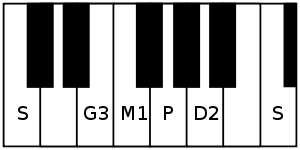Nagasvaravali
Nāgasvarāvaḻi, is a rāgam in Carnatic music (musical scale of South Indian classical music). It is an audava rāgam (or owdava, meaning pentatonic scale). It is a janya rāgam (derived scale), as it does not have all the seven swaras (musical notes).
| Arohanam | S G₃ M₁ P D₂ Ṡ |
|---|---|
| Avarohanam | Ṡ D₂ P M₁ G₃ S |
| Carnatic music |
|---|
Tanjavur-style Tambura |
| Concepts |
| Compositions |
| Instruments |
|
Structure and Lakshana

Nāgasvarāvaḻi is a symmetric rāgam that does not contain rishabham or nishādam. It is a pentatonic scale (audava-audava ragam[1][2] in Carnatic music classification - audava meaning 'of 5'). Its ārohaṇa-avarohaṇa structure (ascending and descending scale) is as follows (see swaras in Carnatic music for details on below notation and terms):
- ārohaṇa : S G₃ M₁ P D₂ Ṡ[lower-alpha 1]
- avarohaṇa : Ṡ D₂ P M₁ G₃ S[lower-alpha 2]
(the notes used in this musical scale are shadjam, antara gandharam, shuddha madhyamam, panchamam, chathusruti dhaivatam)
Nāgasvarāvaḻi is considered a janya rāgam of Harikambhoji, the 28th Melakarta rāgam, though it can be derived from other melakarta rāgams, Chakravakam, Sooryakantam, Shankarabharanam, Vagadheeswari or Shoolini, by dropping both rishabham and nishādam.
Popular compositions
Nāgasvarāvaḻi rāgam has a few compositions in classical music.
- śrīpatē nīpada by Thyagaraja
- gaṃ gaṇapatē sadā by Jayachamaraja Wodeyar
- śrī śaṅkara guruvaraṃ by Maha Vaidyanatha Iyer
- Garuda Gamana by Patnam Subramania Iyer
- bhutapataye namo namaste , bandhamu seyaradu by Muthiah Bhagavatar
- Sivachidambarame by Muthu Thandavar
Related rāgams
This section covers the theoretical and scientific aspect of this rāgam.
Graha bhedam
Nāgasvarāvaḻi's notes when shifted using Graha bhedam, yields another popular pentatonic rāgam, Hamsadhwani. Graha bhedam is the step taken in keeping the relative note frequencies same, while shifting the shadjam to the next note in the rāgam. For more details and illustration of this concept refer Graha bhedam on Hamsadhwani.
Scale similarities
- Mohanam is a rāgam which has chathusruthi rishabham in place of the shuddha madhyamam. Its ārohaṇa-avarohaṇa structure is S R2 G3 P D2 S : S D2 P G3 R2 S
- Shuddha Saveri is a rāgam which has chathusruthi rishabham in place of the antara gandharam. Its ārohaṇa-avarohaṇa structure is S R2 M1 P D2 S : S D2 P M1 R2 S
Notes
- Alternate notations:
- Hindustani: S G M P D Ṡ
- Western: C E F G A C
- Alternate notations:
- Hindustani: Ṡ D P M G S
- Western: C A G F E C
References
- Ragas in Carnatic music by Dr. S. Bhagyalekshmy, Pub. 1990, CBH Publications
- Raganidhi by P. Subba Rao, Pub. 1964, The Music Academy of Madras